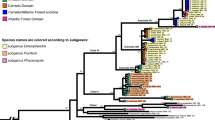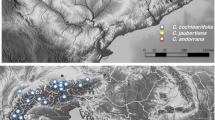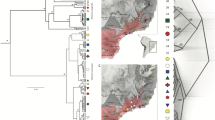Abstract
Cyperaceae tribe Cariceae is characterized by both species richness and habitat diversity, making it an ideal system to study ecological specialization and niche differentiation. We present a phylogenetic hypothesis for the tribe based on nuclear and chloroplast DNA sequence comparisons (ETS-1f, ITS, trnL intron, trnL-trnF intergenic spacer) for 140 representative species from five continents, and use this hypothesis to suggest patterns of both niche conservatism and niche differentiation, particularly within the large subgenus Carex. We identify a new major clade, comprising forest species of East Asian Carex section Siderostictae (subgenus Carex) as sister to the rest of tribe Cariceae. Within Carex subgenus Carex, species tolerant of water-saturated habitats occur in only a few, apparently derived groups, with varying species richness. Clades of predominantly wetland species tend to have broad geographic distribution, often with sister species on different continents, suggesting recent dispersal. In contrast, species within several clades are predominantly forest specialists with distinct Asian and North American lineages. Niche segregation along environmental gradients, such as soil moisture or acidity, is quite common among closely related wetland species, but more difficult to demonstrate within upland forest groups. More complete sampling of species within both wetland and forest groups, combined with comparable sampling of environmental preferences and testing against null models, will be needed for more rigorous exploration of the observed patterns.




Similar content being viewed by others

Literature Cited
Ackerly, D. D. 2003. Community assembly, niche conservatism, and adaptive evolution in changing environments. Int. J. Pl. Sci. 164(suppl.): S165–S184.
Anderson, D. S., R. B. Davis, S. C. Rooney, & C. S. Campbell. 1996. The ecology of sedges (Cyperaceae) in Maine peatlands. Bull. Torrey Bot. Club. 123: 100–110.
Ball, P. W., & A. A. Reznicek. 2002. Carex L. In Flora of North America Editorial Committee (Eds.), Flora of North America, north of Mexico, vol. 23. Magnoliophyta: Commelinidae (in part): Cyperaceae, 254–572. Oxford University Press, New York.
Busch, J. 2001. Characteristic values of key ecophysiological parameters in the genus Carex. Flora 196: 405–430.
Cavender-Bares, J., D. D. Ackerly, D. A. Baum, & F. A. Bazzaz. 2004. Phylogenetic overdispersion in Floridian oak communities. Amer. Nat. 163: 823–843.
Chase, J. M., & M. A. Leibold. 2003. Ecological niches: linking classical and contemporary approaches. University of Chicago Press, Chicago, IL.
Dabros, A. 2004. Distribution patterns of sedges in subarctic fens: ecological and phylogenetic perspectives. M.Sc. thesis, McGill University, Montreal, QC, Canada.
———, & M. J. Waterway. 2004. Differentiation along rooting depth and pH gradients of four Carex species in subarctic fens. Pages 177–179 in R. Danby, H. Castelden, A. Giles, & J. Rausch (eds.). Breaking the Ice: proceedings of the 7th Association of Canadian Universities for Northern Studies Students’ Conference. Canadian Circumpolar Institute, Edmonton, Alberta.
———, & ———. 2008 Segregation of sedge species (Cyperaceae) along environmental gradients in fens of the Schefferville region, northern Quebec. Pages 145–161 in R. F. C. Naczi & B. A. Ford (eds.), Sedges: uses, diversity, and systematics of the Cyperaceae. Monographs in Systematic Botany from the Missouri Botanical Garden:108.
Dai, L.-K., & S.-Y. Liang (eds.) 2000. Flora Reipublicae Popularis Sinicae: delectis florae Reipublicae Popularis Sinicae. Tomus 12. Angiospermae, Monocotyledoneae, Cyperaceae (2), Caricoideae. Science, Beijing, China.
DeBry, R. W., & R. G. Olmstead. 2000. A simulation study of reduced tree-search effort in bootstrap resampling analysis. Syst. Biol. 49: 171–179.
de Vlaming, V. & V. W. Proctor. 1968. Dispersal of aquatic organisms: viability of seeds recovered from the droppings of captive killdeer and mallard ducks. Amer. J. Bot. 55: 20–26.
Dhooge, S. 2005. Systematic revision and phylogeny of the Andean scirpoids (Cyperaceae, Scirpeae). Doctoral dissertation, Universiteit Gent, Belgium.
Egorova, T. V. 1999. The sedges (Carex L.) of Russia and adjacent states (within the limits of the former USSR). St. Petersburg: St. Petersburg State Chemical-Pharmaceutical Academy and Missouri Botanical Garden, St. Louis.
Ellenberg, H. 1991. Indicator values of plants in Central Europe. Scr. Geobot. 18: 9–247.
Ford, B. A., M. Iranpour, R. F. C. Naczi, J. R. Starr, & C. A. Jerome. 2006. Phylogeny of Carex subg. Vignea (Cyperaceae) based on non-coding nrDNA sequence data. Syst. Bot. 31: 70–82.
Gignac, L. D., R. Gauthier, L. Rochefort, & J. Bubier. 2004. Distribution and habitat niches of 37 peatland Cyperaceae species across a broad geographic range in Canada. Can. J. Bot. 82: 1292–1313.
Handel, S. N., S. B. Fisch, & G. E. Schatz. 1981. Ants disperse a majority of herbs in a mesic forest community in New York State. Bull. Torrey Bot. Club 108: 430–437.
Hendrichs, M., S. Michaelski, D. Begerow, F. Oberwinkler, and F. H. Hellwig. 2004. Phylogenetic relationships in Carex, subgenus Vignea (Cyperaceae), based on ITS sequences. Pl. Syst. Evol. 246: 109–125.
Holmgren, P. K., N. H. Holmgren, & L. C. Barnett. 1990. Index herbariorum, Part I: The herbaria of the world, 8th ed. New York Botanical Garden, New York.
Hoshino, T., T. Masaki, & M. Nishimoto. 2002. Illustrated sedges of Okayama. Sanyoshinbunsha, Okayama, Japan.
Hutchinson, J. 1957. Concluding remarks. Cold Spring Harbor Symp. Quant. Biol. 22: 415–427.
Jermy, A. C., A. O. Chater, and R. W. David. 1982. Sedges of the British Isles. Handbook No. 1, Ed. 2. Botanical Society of the British Isles, London, UK. 268 p.
Koyama, T. 1962. Classification of the family Cyperaceae (2). J. Fac. Sci. Univ. Tokyo, Sect. 3, Bot. 8: 149–278.
Kükenthal, G. 1909. Cyperaceae–Caricoideae. In A. Engler (ed.), Das Pflanzenreich, IV. 20 (Heft 38), 1–824. Wilhelm Englemann, Leipzig, Germany.
Levin, D. A. 2004. Ecological speciation: crossing the divide. Syst. Bot. 29: 807–816.
Nylander, J. A. A. 2004. MrModeltest v2. Program distributed by the author. Evolutionary Biology Centre, Uppsala University.
Ohwi, J. 1984. Flora of Japan (in English). Smithsonian Institution, Washington, D.C., USA.
Roalson, E. H., J. T. Columbus, & E. A. Friar. 2001. Phylogenetic relationships in Cariceae (Cyperaceae) based on ITS (nrDNA) and trnT–L–F (cpDNA) region sequences: assessment of subgeneric and sectional relationships in Carex with emphasis on section Acrocystis. Syst. Bot. 26: 318–341.
Ronquist, F., & J. P. Huelsenbeck. 2003. MrBayes 3: Bayesian phylogenetic inference under mixed models. Bioinformatics 19: 1572–1574.
Silvertown, J., M. Dodd, & D. Gowing. 2001. Phylogeny and the niche structure of meadow plant communities. J. Ecol. 89: 428–435.
Simmons, M. P., & H. Ochoterena. 2000. Gaps as characters in sequence-based phylogenetic analyses. Syst. Biol. 49: 369–381.
Starr, J. R., R. J. Bayer, & B. A. Ford. 1999. The phylogenetic position of Carex section Phyllostachys and its implications for phylogeny and subgeneric circumscription in Carex (Cyperaceae). Amer. J. Bot. 86: 563–577.
———, S. A. Harris, & D. A. Simpson. 2003. Potential of the 5’ and 3’ ends of the intergenic spacer (IGS) of rDNA in the Cyperaceae: new sequences for lower-level phylogenies in sedges with an example from Uncinia Pers. Int. J. of Pl. Sci. 164: 213–227.
———, ———, & ———. 2004. Phylogeny of the unispicate taxa in Cyperaceae tribe Cariceae I: generic relationships and evolutionary scenarios. Syst. Bot. 29: 528–544.
———, ———, & ———. 2008 Phylogeny of the unispicate taxa in Cyperaceae tribe Cariceae II: the limits of Uncinia Pers. Pages 243–267 in R. F. C. Naczi and B. A. Ford (eds.), Sedges: uses, diversity, and systematics of the Cyperaceae. Monographs in Systematic Botany from the Missouri Botanical Garden:108.
Swofford, D. L. 2002. PAUP*. Phylogenetic Analysis Using Parsimony (*and Other Methods). vers. 4. Sinauer Associates, Sunderland, Massachusetts, USA.
Tanaka, N. 1939. Chromosome studies in Cyperaceae IV. Chromosome number of Carex species. Cytologia 10: 51–58.
Thompson, J. D., T. J. Gibson, F. Plewniak, F. Jeanmougin, & D. G. Higgins. 1997. The ClustalX-Windows interface: flexible strategies for multiple sequence alignment aided by quality analysis tools. Nucl. Acids Res. 24: 4876–4882.
Vellend, M., M. J. Lechowicz, & M. J. Waterway. 2000. Environmental distribution of four Carex species (Cyperaceae) in an old-growth forest. Amer. J. Bot. 87: 1507–1516.
Waterway, M. J., & J. R. Starr. 2007 Phylogenetic relationships in tribe Cariceae (Cyperaceae) based on nested analyses of four molecular data sets. Pages 165–192 in J. T. Columbus, E. A. Friar, C. W. Hamilton, J. M. Porter, L. M. Prince, & M.G. Simpson (eds.), Monocots, comparative biology and evolution, Poales. Rancho Santa Ana Botanic Garden, Claremont, California, USA.
Westoby, M., D. S. Falster, A. T. Moles, P. A. Vesk, & I. J. Wright. 2002. Plant ecological strategies: some leading dimensions of variation between species. Ann. Rev. Ecol. Syst. 33: 125–160.
Wiens, J. J., & C. H. Graham. 2005. Niche conservatism: integrating evolution, ecology, and conservation biology. Ann. Rev. Ecol. Evol. Syst. 36: 519–539.
Yen, A. C. & R. G. Olmstead. 2000. Molecular systematics of Cyperaceae tribe Cariceae based on two chloroplast DNA regions: ndhF and trnL intron-intergenic spacer. Syst. Bot. 25: 479–494.
Young, N. D., & J. Healy. 2003. GapCoder automates the use of indel characters in phylogenetic analysis. B. M. C. Bioinf. 4: 6.
Zander, R. H. 2004. Minimal values for reliability of bootstrap and jackknife proportions, decay index, and Bayesian posterior probability. PhyloInformatics 2: 1–13.
Zhang, S. R. 2001. A preliminary revision of the supraspecific classification of Kobresia Willd. (Cyperaceae). Bot. J. Linn. Soc. 135: 289–294.
Acknowledgments
We thank T. Katsuyama, M. J. Lechowicz, and Y. Takashima for help with field sampling; Y. Bérubé, N. Blackstock, P. de Lange, J. Dragon, T. Eades, P. Hyatt, S. Mills, and T. W. Smith for providing Carex leaves in silica gel and associated voucher specimens; Y. Bérubé, Y. Chtompel, G. Johnson, P. Talbot, G. Taylor, M.-E. Rheault, and C. Cho for assistance with DNA extraction, amplification and sequencing; the Genome Quebec laboratory at McGill University for DNA sequencing; J. Starr for permission to use three sequences from Starr, Harris & Simpson, in press; A. Dabros and C. Latrémouille for data on environmental preferences; and the Natural Sciences and Engineering Research Council of Canada, the Canadian Foundation for Innovation, and the Fonds Québécois de la recherche sur la nature et les technologies (Québec) for financial support.
Author information
Authors and Affiliations
Corresponding author
Rights and permissions
About this article
Cite this article
Waterway, M.J., Hoshino, T. & Masaki, T. Phylogeny, Species Richness, and Ecological Specialization in Cyperaceae Tribe Cariceae. Bot. Rev 75, 138–159 (2009). https://doi.org/10.1007/s12229-008-9024-6
Published:
Issue Date:
DOI: https://doi.org/10.1007/s12229-008-9024-6



